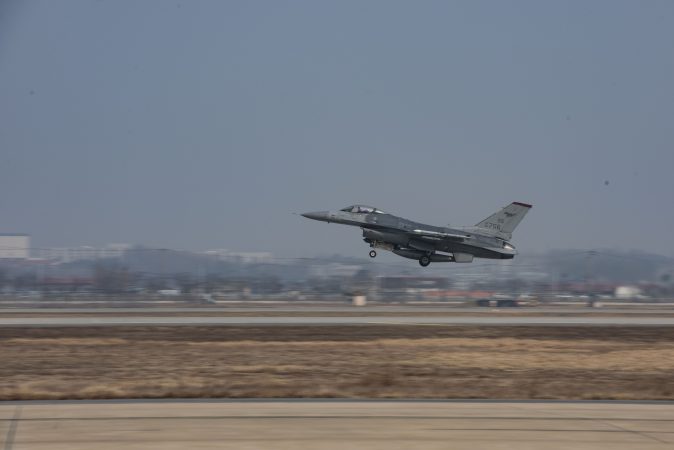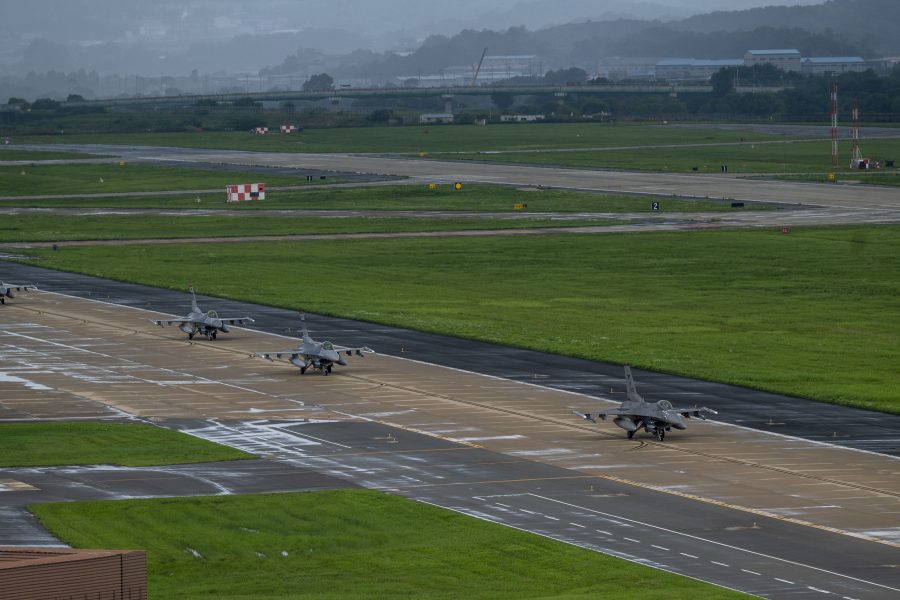The U.S. Air Force will ramp up its presence near North Korea by sending more than two dozen additional F-16 fighters to Osan Air Base, South Korea, creating a second “super squadron” there.
Osan, located just 50 miles south of the Korean border, will welcome 31 extra Vipers and 1,000 Airmen from Kunsan Air Base to its southwest in October, service officials said. The latest move will further centralize the Air Force’s footprint on the peninsula. The Air Force started the “Super Squadron” initiative last year, relocating nine F-16s from Kunsan to Osan, upping the base’s fleet to 31 of the fighters—a number that is now set to double after Air Force Chief of Staff David W. Allvin recently signed off on the standup of the second super squadron.
“This temporary change allows us to test and validate force generation capabilities on the Korean peninsula, ultimately fostering a more lethal, ready air component,” Allvin wrote in a post on X. “The Super Squadron test aims to increase sortie generation and combat capability, while enhancing readiness and responsiveness.”
In a release, Seventh Air Force Commander Lt. Gen. David Iverson said the initiative has been a “success” so far and the Air Force now wants to consolidate its F-16s at Osan to further test the Super Squadron structure.
“The past months of data reveal that we’re on the right track and the consolidated, larger unit has shown some increases in readiness and combat capability, while also exposing some challenges,” said Iverson.
While Air Force officials say no permanent decisions have been made, the service has not specified exactly how long the experiment will last.

The Air Force Personnel Center will begin making assignment updates for the affected Airmen in the coming weeks, according to Lt. Col. Aaron Tissot, Seventh Air Force director of manpower, personnel, and services.
“Our goal is to minimize disruptions and ensure a smooth transition for our Airmen throughout this process,” Tissot said.
The move also comes as Osan is in the process of bidding farewell to its 24 A-10 aircraft, where the 25th Fighter Squadron has flown the venerable close air support aircraft since 1993. Without the A-10, Osan would have been left with only one squadron of aircraft.
The previous F-16 transfer, initiated last summer, was originally intended to last a year. This upcoming second phase will continue to assess these areas on a larger scale, Air Force officials said.
The goal of Super Squadrons is to provide benefits in readiness and training while “reducing manpower and logistic support requirements,” said Lt. Col. Karl Wiest, a spokesperson for Allvin.
Allvin has previously said he wants to decrease excess infrastructure and logistical requirements across the Air Force and reinvest those funds.
“After thorough analysis, Osan was chosen as best able to support the housing and support needs of the Airmen required to execute the Super Squadron test, having recently supported similar personnel requirements during Kunsan’s runway construction project in 2023,” Wiest said.
The previous nine additional F-16s with Osan’s 36th Fighter Squadron supported a number of joint missions, including a recent Freedom Shield exercise in March by “participating in the live-fly exercise portions of the training, engaging in combat training missions focused on air interdiction, close air support, static and dynamic targeting and combat air patrols,” a Seventh Air Force spokesperson told Air & Space Forces Magazine.
Many of these fighters also participated in an ACE exercise, deploying to an alternate base “to rehearse the unit’s ability to quickly maneuver forces around the region while maintaining combat flying operations,” the spokesperson added.

The upcoming transfer will leave Kunsan with a far diminished flightline. Presuming the nine jets previously moved to Osan remain in place, the addition of 31 more would leave Kunsan with only a handful of aircraft.
For the time being however, the host 8th Fighter Wing plans to continue operating as “a primary exercise and rotational force bed-down location for U.S. air component forces in the ROK,” according to the release.
“We acknowledge this is a major shift in how we operate here at Kunsan,” said Col. Peter Kasarskis, 8th Fighter Wing commander. “We’ll meet this change with the same warfighter mindset the Wolf Pack has maintained through our history, and strengthen our ability to accept follow-on forces, defend the base, and take the fight north.”
The wing also plans to maintain active flightline operations and facilities as well as maintaining war reserve material and munitions at multiple locations across the country.
